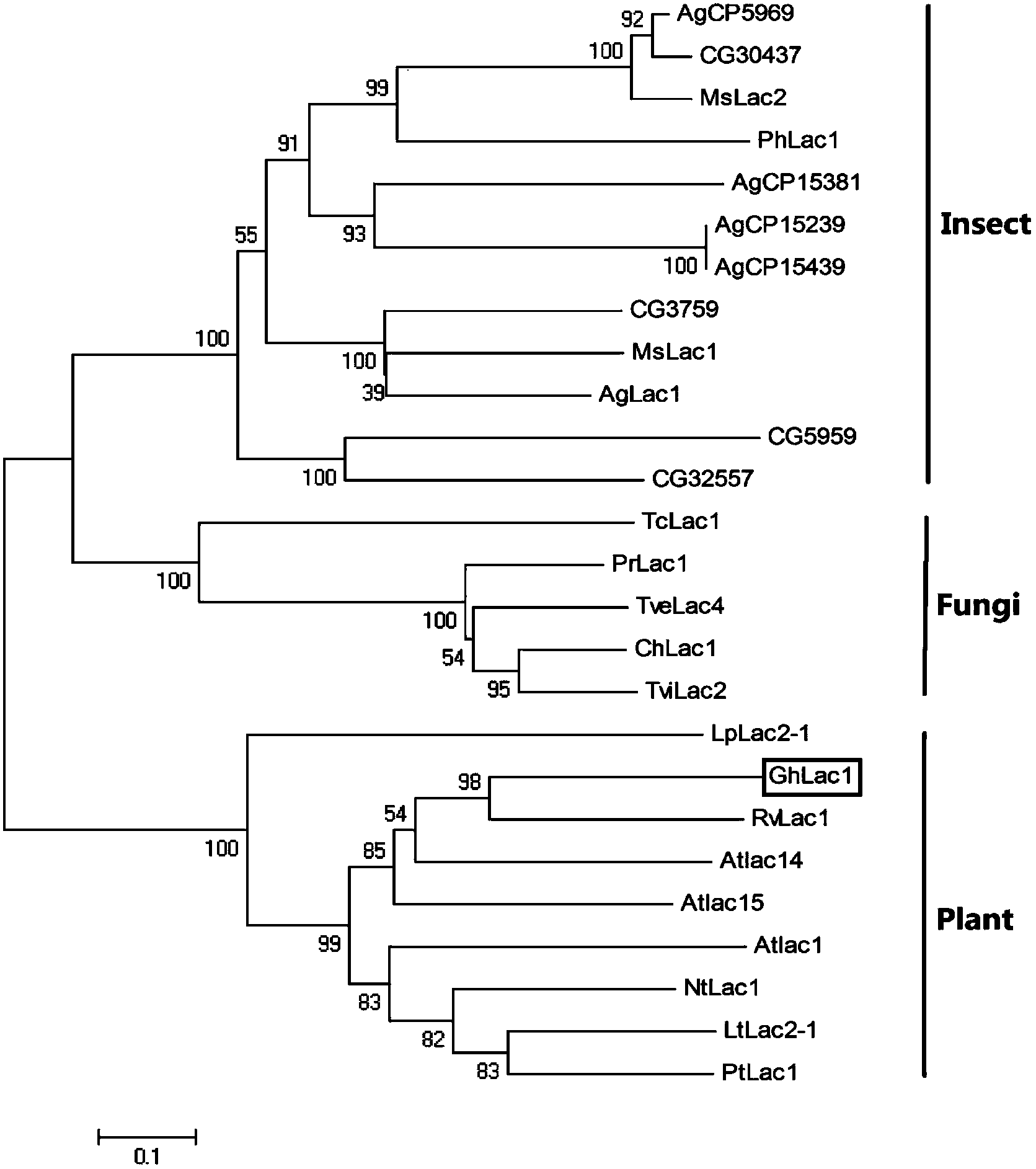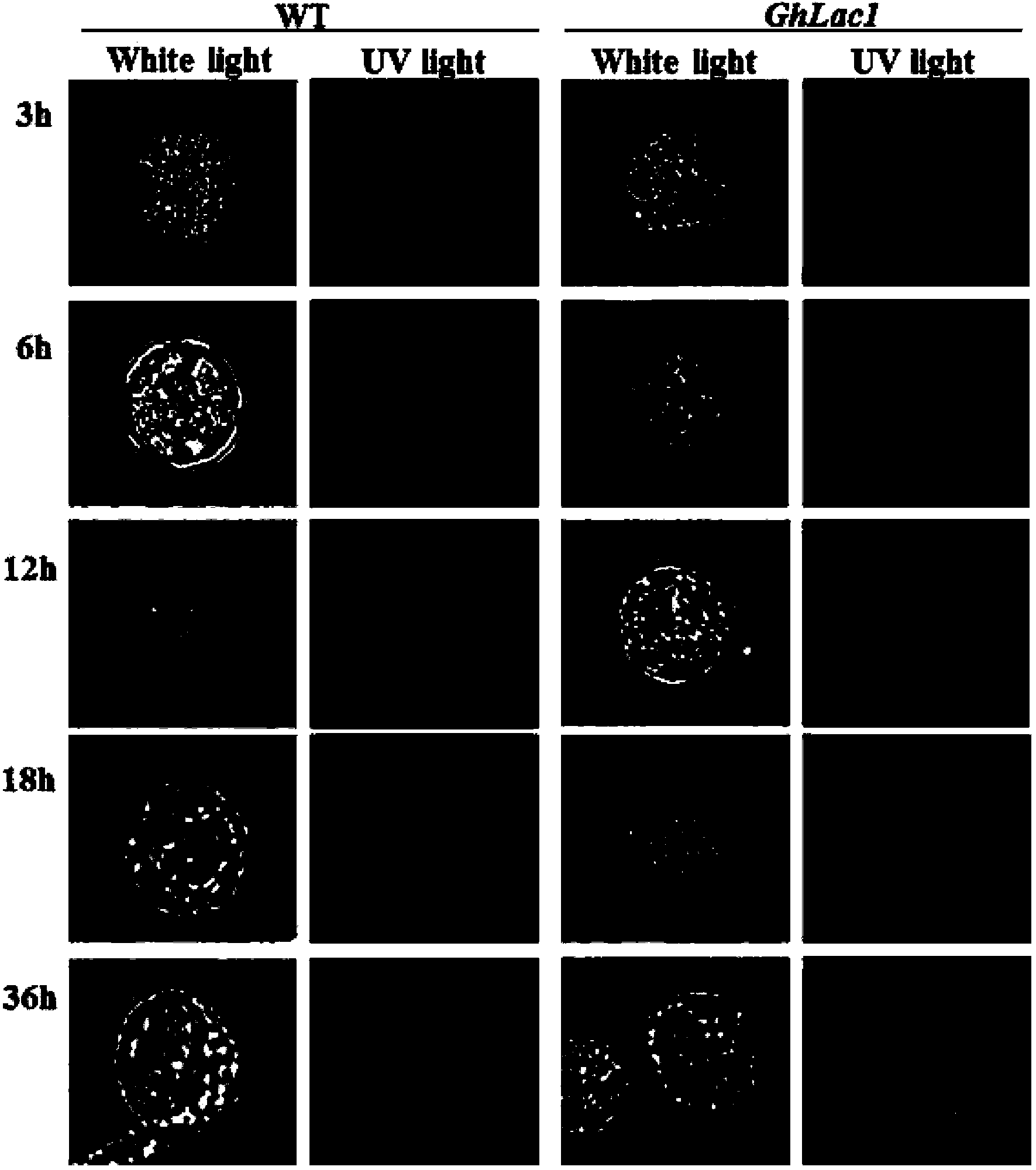GhLac1 gene of broad-spectrum resistance of mediated cotton and application thereof
A cotton, broad-spectrum technology, applied in application, genetic engineering, plant genetic improvement, etc., can solve problems such as unsatisfactory effect, high biological control cost, and large environmental impact.
- Summary
- Abstract
- Description
- Claims
- Application Information
AI Technical Summary
Problems solved by technology
Method used
Image
Examples
Embodiment 1
[0043] Isolation and Cloning of GhLac1 Gene
[0044] 1. Expression Analysis
[0045] The applicant's previous work was to rebuild the SSH (Suppression subtractive hybridization) library from the cotton protoplast cell wall (see literature: Yang et al., Expression profile analysis of genes involved in cell wall regeneration during protoplast culture in cotton by suppression subtractive hybridization and macroarray.2008, 59.3661-3674) to screen and analyze the genes involved in cell wall remodeling, and through the analysis, it was found that there were differences in the expression of a gene at different time points of cell wall remodeling. Identification by RT-PCR demonstrated this distinct expression pattern of the gene (see figure 1 ) Total RNA was extracted from upland cotton line 'YZ-1' at different time points for cell wall reconstruction (extraction method was based on Zhu et al., An improved simple protocol for isolation of high quality RNA from Gossypium spp. suitable...
Embodiment 2
[0051] Construction and transformation of overexpression vector
[0052] In order to verify the function of the GhLac1 gene, the applicant constructed an overexpression vector to transform cotton hypocotyls.
[0053] According to the GhLac1ORF obtained in Example 1, the overexpression primers were designed, and the recombination exchange sites of attB1 and attB2 were added to the two ends of the primers respectively, and the primers were named as GhLac1oe-F (5'
[0054] GGGGACAAGTTTGTACAAAAAAGGCAGGCTTATGGGTTTACAGCAAGGTTTAGTGA3') and GhLac1oe-R (5'GGGGACCACTTTGTACAAGAAAGCTGGGT CTAGGTTCCAGGACAACGAGGCAT3'), and then PCR amplification was carried out using the cDNA of the GhLac1 gene as a template, and the obtained PCR product was constructed into the vector pK2GW7,0 by BP and LR recombination reactions (purchased from Belgian National Ghent University), 2 μl of the recombinant reaction product was electrotransformed into Escherichia coli (E. Coli) competent cell Top10 (purchased ...
Embodiment 3
[0117] pK2GW7, 0-GhLac1 embryogenic callus cell wall remodeling
[0118] According to the method reported by Yang et al. (Yang et al., 2007, Production and characterization of asymmetric hybrids between upland cotton Coker201(Gossypium hirsutum) and wild cotton(G.klozschianum Anderss).Plant Cell, Tissue and Organ Culture89, 225-235) , isolate the protoplasts of GhLac1 and YZ-1 embryogenic callus, the specific process is as follows:
[0119] 1. Take about 0.1 g of GhLac1 and YZ-1 embryogenic calli, suspend them in the enzyme solution sterilized by filtration, shake gently (40 r / min) at 28±1° C. for 16-20 h to separate protoplasts. The composition of the enzyme liquid is as follows: 1.5% (w / v) Cellulase Onozuka R-10, 1% (w / v) Macerozyme R-10 and 2% (w / v) Hemicellulase dissolved in protoplasts Lotion CPW9M.
[0120] CPW9M formula:
[0121]
[0122] 2. The enzymatically hydrolyzed protoplasts were filtered through a double-layer stainless steel mesh with a pore size of 100 a...
PUM
 Login to View More
Login to View More Abstract
Description
Claims
Application Information
 Login to View More
Login to View More - R&D
- Intellectual Property
- Life Sciences
- Materials
- Tech Scout
- Unparalleled Data Quality
- Higher Quality Content
- 60% Fewer Hallucinations
Browse by: Latest US Patents, China's latest patents, Technical Efficacy Thesaurus, Application Domain, Technology Topic, Popular Technical Reports.
© 2025 PatSnap. All rights reserved.Legal|Privacy policy|Modern Slavery Act Transparency Statement|Sitemap|About US| Contact US: help@patsnap.com



